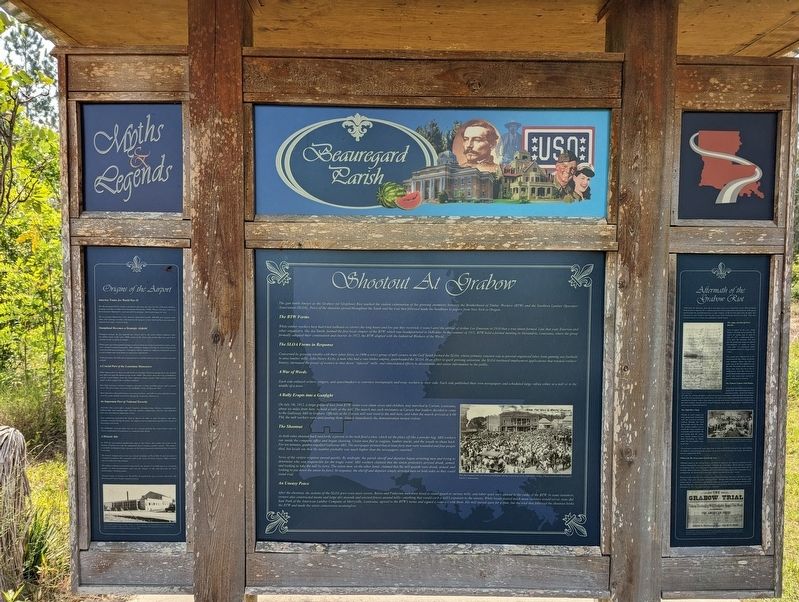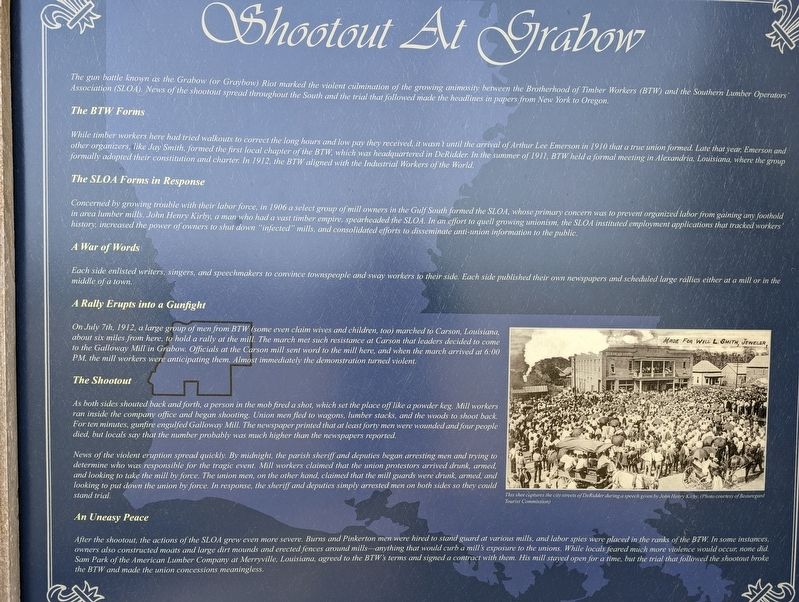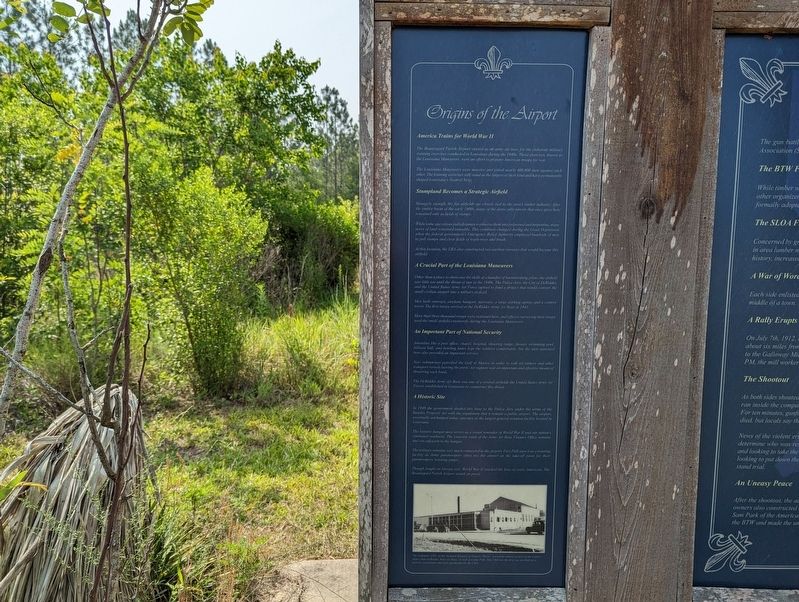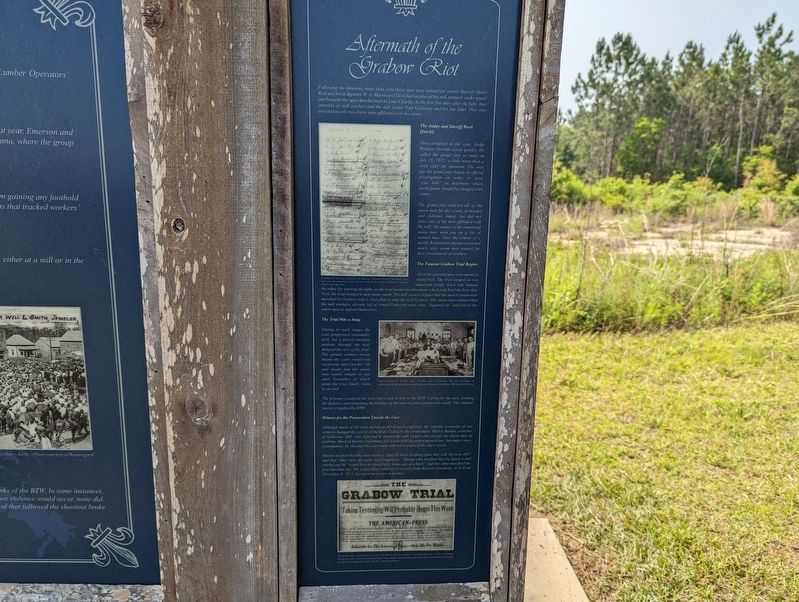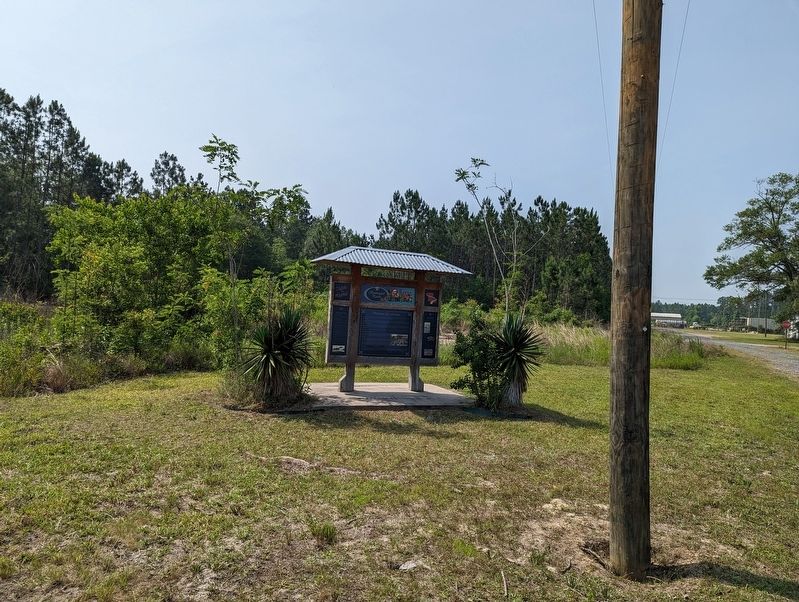DeRidder in Beauregard Parish, Louisiana — The American South (West South Central)
Shootout At Grabow
Louisiana Myths and Legends Byways
— Beauregard Parish —
The gun battle known as the Grabow (or Graybow) Riot marked the violent culmination of the growing animosity between the Brotherhood of Timber Workers (BTW) and the Southern Lumber Operators' Association (SLOA). News of the shootout spread throughout the South and the trial that followed made the headlines in papers from New York to Oregon.
The BTW Forms
While timber workers here had tried walkouts to correct the long hours and low pay they received, it wasn't until the arrival of Arthur Lee Emerson in 1910 that a true union formed. Late that year, Emerson and other organizers, like Jay Smith, formed the first local chapter of the BTW, which was headquartered in DeRidder. In the summer of 1911, BTW held a formal meeting in Alexandria, Louisiana, where the group formally adopted their constitution and charter. In 1912, the BTW aligned with the Industrial Workers of the World.
The SLOA Forms in Response
Concerned by growing trouble with their labor force, in 1906 a select group of mill owners in the Gulf South formed the SLOA, whose primary concern was to prevent organized labor from gaining any foothold in area lumber mills. John Henry Kirby, a man who had a vast timber empire, spearheaded the SLOA. In an effort to quell growing unionism, the SLOA instituted employment applications that tracked workers' history, increased the power of owners to shut down "infected" mills, and consolidated efforts to disseminate anti-union information to the public.
A War of Words
Each side enlisted writers, singers, and speechmakers to convince townspeople and sway workers to their side. Each side published their own newspapers and scheduled large rallies either at a mill or in the middle of a town.
A Rally Erupts into a Gunfight
On July 7th, 1912, a large group of men from BTW (some even claim wives and children, too) marched to Carson, Louisiana, about six miles from here, to hold a rally at the mill. The march met such resistance at Carson that leaders decided to come to the Galloway Mill in Grabow. Officials at the Carson mill sent word to the mill here, and when the march arrived at 6:00 PM, the mill workers were anticipating them. Almost immediately the demonstration turned violent.
The Shootout
As both sides shouted back and forth, a person in the mob fired a shot, which set the place off like a powder keg. Mill workers ran inside the company office and began shooting. Union men fled to wagons, lumber stacks, and the woods to shoot back. For ten minutes, gunfire engulfed Galloway Mill. The newspaper printed that at least forty men were wounded and four people/ died, but locals say that the number probably was much higher than the newspapers reported. News of the violent eruption spread quickly. By midnight, the parish sheriff and deputies began arresting men and trying to determine who was responsible for the tragic event. Mill workers claimed that the union protestors arrived drunk, armed, and looking to take the mill by force. The union men, on the other hand, claimed that the mill guards were drunk, armed, and looking to put down the union by force. In response, the sheriff and deputies simply arrested men on both sides so they could stand trial.
An Uneasy Peace
After the shootout, the actions of the SLOA grew even more severe. Burns and Pinkerton men were hired to stand guard at various mills, and labor spies were placed in the ranks of the BTW. In some instances, owners also constructed moats and large dirt mounds and erected fences around mills—anything that would curb a mill's exposure to the unions. While locals feared much more violence would occur, none did. Sam Park of the American Lumber Company at Merryville, Louisiana, agreed to the BTW's terms and signed a contract with them. His mill stayed open for a time, but the trial that followed the shootout broke the BTW and made the union concessions meaningless.
Aftermath of the Grabow Riot
Following the shootout, more than sixty-three men were wanted for arrest. Sherriff Henry Reid and local deputies W. A. Martin and Del Charlan placed the mill property under guard and brought the apprehended men to Lake Charles. In the first few days after the fight, they arrested six mill workers and the mill owner Paul Galloway and his son John. They also arrested nearly two dozen men affiliated with the union.
The Judge and Sheriff Work Quickly
Once assigned to the case, Judge Winston Overton acted quickly. He called the grand jury to meet on July 15, 1912, a little more than a week after the shootout. The next day the grand jury began its official investigation in order to issue "true bills" to determine which participants should be charged with crimes. The grand jury indicted all of the union men for the crimes of murder and seditious intent, but did not indict any of the men affiliated with the mill. The names of the remaining union men were put on a list of wanted men. Over the course of a month, Reid and his deputies arrested nearly sixty union men wanted for their involvement at Grabow.
The Famous Grabow Trial Begins
All of the arrested men were meant to stand trial. The trial hinged on two important points. Each side blamed the other for starting the fight, so the trial needed to determine which side fired the first shot. Next, the trial needed to determine intent. The mill owners argued that the mob of union men marched to Grabow with a clear plan to take the mill by force. The union men claimed that the mill workers, already full of armed Pinkerton men, were "liquored-up" and forced the union men to defend themselves.
The Trial Hits a Snag
During its early stages the trial progressed reasonably well, but a forced vacation midway through the trail delayed the rest of the trial! The annual summer recess meant the court would not reconvene until October 7th and meant that the union men would remain in jail until November, at which point the trial finally came to an end. The prisoners endured the wait, but it took its toll on the BTW. Caring for the men, funding the defense, and sustaining the families of the men in prison proved too costly. The expense forever crippled the BTW.
Witness for the Prosecution Upends the Case
Although much of the trial moved as the lawyers expected, the surprise testimony of one witness changed the course of the trial. Called by the prosecution, Shirley Buxton, a worker at Galloway Mill, was expected to defend the mill owners and accuse the union men of sedition. Much of Buxton's testimony fell in line with the prosecution's case, but under cross- examination, he shocked the courtroom with his account of the day's events. Buxton testified that the mill workers "had all been drinking what they call Mexican Hot" and that "they were all pretty well organized." Buxton also testified that he heard a mill worker say he would love to shoot every union son of a bitch" and this same man fired the first shot that day. The prosecution could never recover from Buxton's testimony. At 4:45 on November 8, 1912, the union men were acquitted.
Origins of the Airport
America Trains for World War II
The Beauregard Parish Airport started as an army air base for the elaborate military training exercises conducted in Louisiana during the 1940s. These exercises, known as the Louisiana Maneuvers, were an effort to prepare American troops for war: The Louisiana Maneuvers were massive and pitted nearly 400,000 men against each other. The training exercises still stand as the largest of their kind and have permanently shaped Louisiana's Neutral Strip.
Stumpland Becomes a Strategic Airfield
Strangely enough, the flat airfields are closely tied to the area's timber industry: After the timber boom of the early 1900s, many of the dense pine forests that once grew here remained only as fields of stumps. While some operations pulled stumps to process them into pulpwood and turpentine, many acres of land remained unusable. This condition changed during the Great Depression when the federal government's Emergency Relief Authority employed hundreds of men to pull stumps and clear fields of trash-trees and brush. At this location, the ERA also constructed two earthen runways that would become this airfield.
A Crucial Part of the Louisiana Maneuvers
Other than a place to showcase the skills of a handful of barnstorming pilots, the airfield saw little use until the threat of war in the 1940s. The Police Jury, the City of DeRidder, and the United States Army Air Force agreed to fund a project that would convert the small civilian airport into a military airfield. Men built runways, airplane hangars, taxiways, a large parking apron, and a control tower. The first troops arrived at the DeRidder Army Air Base in 1941. More than three thousand troops were stationed here, and officers surveying their troops used the small airfield extensively during the Louisiana Maneuvers.
An Important Part of National Security
Amenities like a post office, chapel, hospital, shooting range, theater, swimming pool, billiard hall, and bowling lanes kept the soldiers comfortable, but the men stationed here also provided an important service. Nazi submarines patrolled the Gulf of Mexico in order to sink oil tankers and other transport vessels leaving the ports. Air support was an important and effective means of thwarting such boats. The DeRidder Army Air Base was one of a several airfields the United States Army Air Forces established in Louisiana to counteract this threat.
A Historic Site
In 1948 the government deeded this base to the Police Jury under the terms of the Surplus Property Act with the stipulation that it remain a public airport. The airport, essentially unchanged today, operates as the largest general aviation facility located in Louisiana. The historic hangar area serves as a visual reminder of World War II and our nation's continued readiness. The concrete vault of the Army Air Base Finance Office remains and sits adjacent to the hangar The military remains very much connected to the airport. Fort Polk uses it as a training facility as Army paratroopers often use the airport as the take-off point for their paratroopers' training jumps. Though fought on foreign soil, World War II touched the lives of every American. The Beauregard Parish Airport stands as proof.
Erected by State of Louisiana. (Marker Number 8.)
Topics. This historical marker is listed in these topic lists: Industry & Commerce • Labor Unions • Law Enforcement. A significant historical date for this entry is July 7, 1912.
Location. 30° 50.03′ N, 93° 19.928′ W. Marker is in DeRidder, Louisiana, in Beauregard Parish. Marker is on A Street near 4th Street. Touch for map. Marker is at or near this postal address: D St, Deridder LA 70634, United States of America. Touch for directions.
Other nearby markers. At least 8 other markers are within 11 miles of this marker, measured as the crow flies. World War II DeRidder Army Air Base Memorial (approx. 0.7 miles away); Grabow Riot (approx. 1.3 miles away); Beauregard Parish Gothic Jail (approx. 2.7 miles away); DeRidder - The Sawmill Hub (approx. 2.8 miles away); Sam Houston Jones (approx. 2.9 miles away); Rosepine, Louisiana (approx. 6.6 miles away); Shady Grove School/Community Building (approx. 9.6 miles away); Atákapa Trace Junction (approx. 10˝ miles away). Touch for a list and map of all markers in DeRidder.
Credits. This page was last revised on July 23, 2023. It was originally submitted on July 23, 2023, by Cajun Scrambler of Assumption, Louisiana. This page has been viewed 93 times since then and 32 times this year. Photos: 1, 2, 3, 4, 5. submitted on July 23, 2023, by Cajun Scrambler of Assumption, Louisiana.
